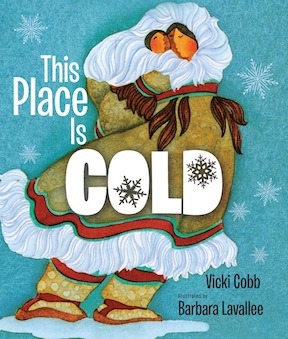
After the longest hiatus in my career, I have a book coming out early next year called This Place Is Cold. Actually, it’s not a new book. It is a revised version of a book originally published in 1989 that never went out-of-print. But after a 24-year run (not bad!) I was asked to take a look at it and cut it so it wouldn’t look so “text heavy.” (Subtext: today’s kids have shorter attention spans; it must look less wordy.) I was also to update the relevant information, especially about global warming. The designer would give it a fresh new look but the fabulous art, by my dear friend Barbara Lavallee, still makes this a book anyone would want to pick up.
After spending the past three years writing more than ever for blogs, and emails, and other business related projects, the various stages of This Place Is Cold that required my review suddenly made me aware of how much attention goes into the making of a book product for children. It was in stark contrast to my current writing, which is read only by my eyes before it is published. (Of course, we all know that online publications are only for the moment. No one expects them to be perfect.)
First, there was the editing — queries from my editor who worked on the revisions script. Next came the copy-edited manuscript, where I had to respond to tiny details that I thought I had already answered. For example, I wrote:
“It's no big deal to have a pilot's license in Alaska. One person in every sixty-one has one.” (The original version said “One person in every seventy-six has one.”) I had to check on those figures twice for two different passes.
I was struck by the care that was taken and the sheer number of times this small book had been read by so many different people. So I asked one of my editors, Mary Kate Castellani, if she could fill me in on the process. How many times is a book read and corrected before it is released to the world? Here’s her summation, plus my comments in parenthesis:
• Author and editor work on manuscript. (Who knows how many readings that involves!)
• Manuscript is copyedited and if a work of nonfiction, all the facts are checked against trusted sources. Any information that can’t be confirmed independently of the author will need to be sourced by the author. (Copy editors read a manuscript several times.)
• Copy edited manuscript is sent to author for corrections. Then returned and checked. (A couple of more readings)
• Artwork is also turned in and checked for errors, inconsistencies and any other problems. Once the art is corrected, it is sent to a printer in Far East to make hi-resolution scans for the book design.
• Manuscript is sent, along with cover copy and any additional information to the designer.
• Designer creates design samples to share with editor to preview font choices, and general design elements.
• Editor shares design samples with the author.
• Once design samples are approved, designer sets entire book from start to finish using hi-res scans from printer.
• A first pass set of mechanicals (initial layouts) is then routed in-house where editor, production editor, publisher, school and library marketing director, and art director all review. (Five more readings!)
• Sets of mechs are simultaneously sent to author and illustrator to review for errors or any issues with layout. (Two more readings.)
• All queries and comments are resolved, and mechs are sent back to designer to input all changes and make any design adjustments. The designer then routes the second pass mechs to route in house again, this time only to the editor, productions editor and managing editor. Any major changes may be shown to the author/illustrator once more. (Another five readings.)
• Book closes for proofing and is sent to printers in Far East.
• F&Gs (folded and gathered sheets) are pulled from the proofing stage.
• Proofs are sent to New York office to be reviewed in house for any errors. Sets of proofs are sent to author and illustrator for one last review. At this point any changes cost money at the printer, so should be reserved for major changes/errors.
• Art director and designer check proofs against original art to make sure the color is as it should be.
• Proofs are returned to printer for final printing.
• Printer sends one last set of plotters to check for any last errors.
• Plotters are approved and books are printed.
With so many opportunities for the author/illustrator and the in-house editors to check the pages, the book is printed without mistakes. While an error certainly does happen every once in a while, we always correct any mistakes if and when the book is reprinted. In my time at Walker, there have been only a handful of errors — usually reported by readers, who do very careful reads of their own!
By my calculations, a thirty-two page picture book of 3,000 words (5 typewritten pages single spaced) is reviewed by at least seven people, each reading it an average of four times — 25+ readings before it becomes a book. Talk about dotting the i’s and crossing the t’s! This much investment is a statement about honor and pride of workmanship but mostly it is a tribute to the ultimate user — children. In the writer’s jargon of “show, don’t tell” my book shows them, “We’re giving you our very best. It’s what you deserve.” It is also designed to last and to be treasured.


